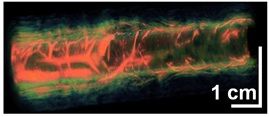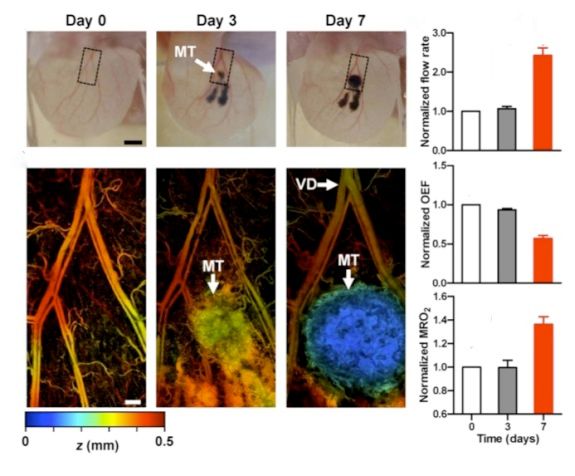New Clinical Imaging Tech Promises Improved Image Quality
Researchers want to make photoacoustic tomography, which pairs light and sound, available to providers. Clinical trials are already under way to visualize sentinel lymph nodes for breast cancer staging – just one of several potential applications of this technology.
If you had the opportunity to test a technology that gave you clear, full-color images from deeper within the body, would you do it? You could soon find yourself faced with this question as photoacoustic tomography works its way through the clinical trial process.
Investigators have researched this technology that pairs light and sound for roughly 20 years. Now, biomedical engineers from Washington University at St. Louis have taken steps to make the health-hazard-free imaging method available to providers and patients. And clinical trials are already under way to visualize sentinel lymph nodes for breast cancer staging – just one of several potential applications of this technology.
“My hope is that photoacoustic tomography will impact both basic science research and clinical utility,” said Lihong Wang, PhD, Washington University’s Gene K. Beare Distinguished Professor of Biomedical Engineering, who details this new imaging technology in the March 23 issue of Science. “Photoacoustic enables bio-research on many scales. Clinically, we hope it accelerates the translation of microscopic lab discoveries to the macro clinical practice. Very few discoveries ever translate to the clinic, and we believe photoacoustic will make bridging that gap much smoother.”
How It Works
Instead of relying solely on the easily-scattered light photons used in X-rays to provide images, photoacoustic tomography converts light absorbed in soft tissue into sound waves and irradiates the targeted tissue with a nanosecond-pulsed laser set to an optical wavelength. These sound waves break apart 1,000 times less than light, allowing you to gather images at a depth of 7 centimeters - 70 times deeper than X-ray.

According to Lihong Wang, some of the molecules absorbed in tissues produce heat that pushes sound waves to the skin’s surface. Ultrasound receivers collect that data and create images, similar to photographs, that have higher contrasts than X-rays. Naturally-colored molecules, such as hemoglobin and melanin, work as they body’s own contrast agents and cooperate with organic dyes or other genetically-engineered genes to help produce the images.
“A lot of the information we have comes from the visual world,” he said. “By using photoacoustic in the body, we can mimic what we see with the naked eye. Firing these photons into tissue produces very good images.”
Impact on Radiology
Clinical trials have already begun to test whether photoacoustic tomography is effective in breast cancer staging and chemotherapy monitoring. Lihong Wang’s team also plans to test its efficacy with skin cancer and gastrointestinal imaging in the future.
In the breast cancer trial, Lihong Wang and colleagues hope to demonstrate that radiologists can use photoacoustic tomography with the optical dye methylene blue to visually track cancer metastasis and identify lymph nodes for biopsy. Doing so could drastically reduce the number of unnecessary surgical biopsies.
Pinpointing lymph nodes this way is more accurate and can reduce the number of invasive surgeries that are often superfluous, Lihong Wang said. Surgical biopsies reveal cancer in only 10 percent of patients, and 5 percent of those patients experience a negative outcome, such as swelling, limited range of motion, or nerve damage, after the procedure.
“We’re trying to convert these surgeries to needle biopsies by using organic dye only,” Lihong Wang said. “Radiologists don’t need to use radioactive material - the dye shows up in photoacoustic images because it’s a good light absorber at the red wave length.”
This method would also help patients avoid the pain and high cost of surgical biopsies.
In addition, photoacoustic tomography can determine early how well a particular chemotherapy treatment is working, he said. The technology can pick up whether blood is bright red, indicating a high oxygen saturation. By identifying abnormally high levels of saturation, as well as blood vessel density and concentration - all hallmarks of the presence of cancer - photoacoustic tomography can gauge a treatment’s efficacy. If the image identifies an ineffective treatment, doctors can shift courses sooner, potentially making a positive impact on patient health.
The Road Ahead
Although investigators have demonstrated in the lab that photoacoustic tomography can target breast cancer with millimeter accuracy and can expose failing chemotherapy, there’s still much work to be done before the clinical community knows how to best use this technology. According to Xueding Wang, PhD, assistant radiology and biomedical engineering professor at the University of Michigan, finding the optimal way to apply it will require collaboration between researchers and physicians.
“Our opinion at Michigan is that this is a good technology, but we need to find the best use for it,” said Xueding Wang, who has studied photoacoustic tomography for the past decade and conducted research with Lihong Wang previously. “Researchers and physicians need to keep looking at this because, right now, we haven’t identified the best application. Right now, we haven’t proven anything clinically.”
Xueding Wang and Lihong Wang are not related, and Xueding Wang was not involved in the publication of this current paper.
In fact, Xueding Wang said, he’s actively pursuing how this technology can be used to positively impact patients with inflammatory arthritis, a disease second in cost to only cardiac disease. Other investigators are also looking into whether photoacoustic tomography would be useful in prostate cancer cases.
Regardless of the application, however, investigators and providers must partner to test the technology in clinical environments.
“Lab researchers need to work closely with physicians so we can understand what they need and not just tell them what we can do,” Xueding Wang said. “What we can do matters. What they need matters. If we meet together, then something good will happen.”

Meta-Analysis Shows Merits of AI with CTA Detection of Coronary Artery Stenosis and Calcified Plaque
April 16th 2025Artificial intelligence demonstrated higher AUC, sensitivity, and specificity than radiologists for detecting coronary artery stenosis > 50 percent on computed tomography angiography (CTA), according to a new 17-study meta-analysis.
The Reading Room: Racial and Ethnic Minorities, Cancer Screenings, and COVID-19
November 3rd 2020In this podcast episode, Dr. Shalom Kalnicki, from Montefiore and Albert Einstein College of Medicine, discusses the disparities minority patients face with cancer screenings and what can be done to increase access during the pandemic.
Could Lymph Node Distribution Patterns on CT Improve Staging for Colon Cancer?
April 11th 2025For patients with microsatellite instability-high colon cancer, distribution-based clinical lymph node staging (dCN) with computed tomography (CT) offered nearly double the accuracy rate of clinical lymph node staging in a recent study.